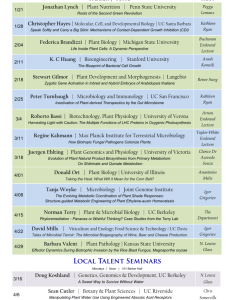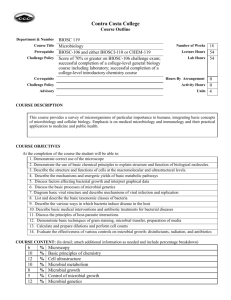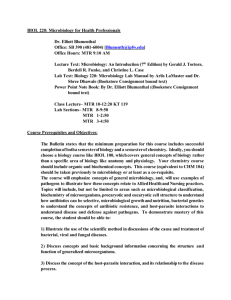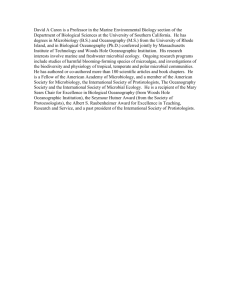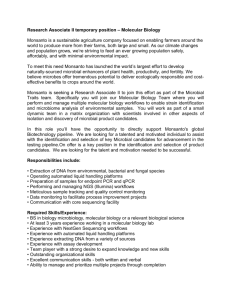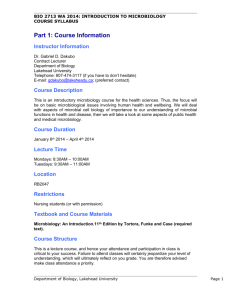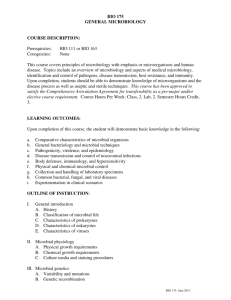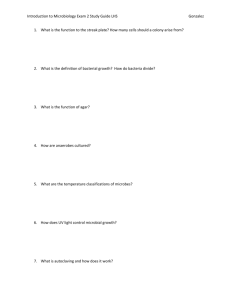Diapositiva 1
advertisement
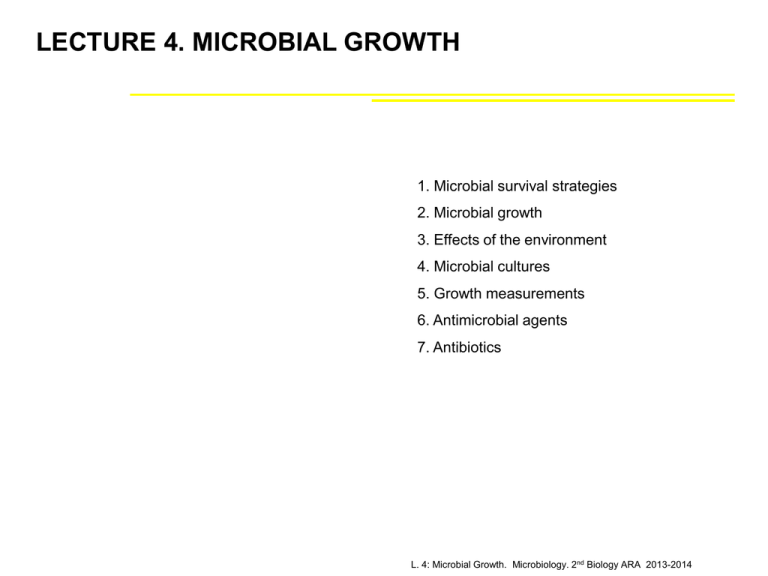
LECTURE 4. MICROBIAL GROWTH 1. Microbial survival strategies 2. Microbial growth 3. Effects of the environment 4. Microbial cultures 5. Growth measurements 6. Antimicrobial agents 7. Antibiotics L. 4: Microbial Growth. Microbiology. 2nd Biology ARA 2013-2014 1. MICROBIAL SURVIVAL STRATEGIES PROKARYOTES: MINIATURIZATION EUKARYOTES: COMPLEXITY Prokaryotes – r strategists: “the advantages of being small” Surface/Volumen Metabolic rates (osmotrophs) Rapid growth, short generation times Population-level adaptation Eukaryotes –K strategists: “the advantages of being complex” Phagocytosis Complex genomes Rapid movement Independence from the environment Complex sensor and motor systems Individual-level adaptation L. 4: Microbial Growth. Microbiology. 2nd Biology ARA 2013-2014 2. MICROBIAL GROWTH GROWTH (IN MICROBIOLOGY)=INCREASE IN CELL NUMBER 2.1. CELL DIVISION AND PARTITION OF CELL COMPONENTS DNA replication and cell elongation Septum formation Completion of septum with formation of distinct walls Cell separation Binary fission vs other L. 4: Microbial Growth. Microbiology. 2nd Biology ARA 2013-2014 2. MICROBIAL GROWTH 2.1. CELL DIVISION AND PARTITION OF CELL COMPONENTS Partition of cell components: random (except DNA) PROTEINS Fts DNA SEGREGATION: DNA binds to the cytoplasmic membrane Bidirectional replication (in one fork) Several simultaneous forks L. 4: Microbial Growth. Microbiology. 2nd Biology ARA 2013-2014 3. EFFECTS OF THE ENVIRONMENT 3.1. NUTRIENT CONCENTRATION At a very low nutrient concentration, permeases cannot keep high levels of nutrients inside the cell and growth rate decreases. However, high nutrient concentrations can be toxic for many microorganisms 3.2. PREASURE Al sea level = 1 atm In the oceans up to 600 -1.100 atm • No barotolerant • Barotolerant • Barophile (or piezophile) L. 4: Microbial Growth. Microbiology. 2nd Biology ARA 2013-2014 3. EFFECTS OF THE ENVIRONMENT 3.3. TEMPERATURE Enzymatic reactions occurring at maximum possible rate Enzymatic reactions occrring at increasingly rapid rates Membrane gelling; transport processes so slow that growth cannot occur Protein denaturation; collapse of the cytoplasmic membrane;thermal lysis • Psychrophile ( 0 - 20ºC) • Mesophile (10 - 50ºC) • Termophile (50 - 70ºC) • Hyperthermophile (80 121ºC*) Adaptations to high temperatures Adaptations to low temperatures Thermoresistent proteins (enzymes) Proteins (enzymes) that function optimally in the cold Stable membranes ( saturated fatty acids) Archaea, special membranes (lipid monolayers) Modified active transport processes Fluidity of membranes ( unsaturated fatty acids) L. 4: Microbial Growth. Microbiology. 2nd Biology ARA 2013-2014 3. EFFECTS OF THE ENVIRONMENT 3.4. OXYGEN CONCENTRATION TOXIC OXYGEN SPECIES: Singlet oxygen (1O2) Superoxide (O2-) Hydrogen peroxide (H2O2) Hydroxyl radical (OH-) Enzymes that destroy them 1 2 3 4 5 Aerobic (1) Microaerophilic (aerobic) (4) Facultative (3) Aerotolerant anaerobe(5) (Strict) anaerobic (2) L. 4: Microbial Growth. Microbiology. 2nd Biology ARA 2013-2014 L. 4: Microbial Growth. Microbiology. 2nd Biology ARA 2013-2014 3. EFFECTS OF THE ENVIRONMENT 3.5. pH L. 4: Microbial Growth. Microbiology. 2nd Biology ARA 2013-2014 3. EFFECTS OF THE ENVIRONMENT 3.6. OSMOLARITY Adaptations to high salt Counterbalance of external osmotic preasure by accumlation of: -Inorganic ions (K+) . Acidic proteins! Archaea and some extremely halophilic Bacteria. -Compatible organic solutes (either imported or synthesized): glycine betaine, proline, glycerol, etc. L. 4: Microbial Growth. Microbiology. 2nd Biology ARA 2013-2014 3. EFFECTS OF THE ENVIRONMENT 3.7. RADIATIONS Photodynamic effect: light-mediated generation of singlet oxygen ( 1O2 ) Carotenoids: photoprotectant pigments transform 1O2 into non toxic species Radiotolerant microorganisms: Bacterial endospores Deinococcus radiodurans L. 4: Microbial Growth. Microbiology. 2nd Biology ARA 2013-2014 3. EFFECTS OF THE ENVIRONMENT 3.8. EXTREMOPHILISM AND EXTREMOPHILES L. 4: Microbial Growth. Microbiology. 2nd Biology ARA 2013-2014 4. MICROBIAL CULTURES CULTURE: a system used to allow the multiplication of a microbial population and reach a high microbial density Culture components: Nutrients (medium) Inoculum (absence of contamination) (According to the metabolic categories): C source E source Macronutrients (N, O, P, S, salts, vitamins, etc.) Micronutrients (normally, present as salt contaminants) H2O pH (buffers) WARNING! Auxotrophs vs prototrophs Types of culture media: Liquid / solid Defined, synthetic Complex Selective “Test”… Culture types: Pure (or axenic) Mixed Preparation Sterilization Inoculation Incubation L. 4: Microbial Growth. Microbiology. 2nd Biology ARA 2013-2014 4. MICROBIAL CULTURES L. 4: Microbial Growth. Microbiology. 2nd Biology ARA 2013-2014 4. MICROBIAL CULTURES 4.1. BATCH (DISCONTINUOUS) CULTURE Closed system (only energy, and sometimes gases, are interchanged with the external environment; no cells or disolved products). Growth curve with 4 phases. L. 4: Microbial Growth. Microbiology. 2nd Biology ARA 2013-2014 4. MICROBIAL CULTURES 4.1. BATCH CULTURE Exponential growth N = N02n N= Number of cells after n generations N0 = Number of cells at the beginning tg = Generation time (time needed to double cell number) = specific growth rate (time units -1) (number of generations per time unit) tg = ln 2 / (hours) L. 4: Microbial Growth. Microbiology. 2nd Biology ARA 2013-2014 4. MICROBIAL CULTURES 4.1. BATCH CULTURE L. 4: Microbial Growth. Microbiology. 2nd Biology ARA 2013-2014 4. MICROBIAL CULTURES 4.1. BATCH CUTURE Escherichia coli Tg= 20 min After 48 hours 4000 X Earth weight µ depends on nutrient concentration LIMITING SUBSTRATE Net growth: final biomass – initial biomass (inoculum) Yield: unit of biomass produced per unit of nutrient consumed Y = (X – Xo) / S Y = yield X, Xo = cells/ ml S = nutrient concentration at to µ = µ max S Ks + S L. 4: Microbial Growth. Microbiology. 2nd Biology ARA 2013-2014 4. MICROBIAL CULTURES 4.2. CONTINUOUS CULTURE (“steady state”) Cultures can be kept for long periods of time. Medium is added and culture removed, keepin V constant V entrance constant, [nutrient] constant, [cell] constant. V changes, µ changes and a new [cell] is reached L. 4: Microbial Growth. Microbiology. 2nd Biology ARA 2013-2014 4. MICROBIAL CULTURES 4.2. CONTINUOUS CULTURE (“steady state”) Biomass (X) constant in time. dX/dt = 0 Vproduction (cells produced) = Vlosses (cells removed) L. 4: Microbial Growth. Microbiology. 2nd Biology ARA 2013-2014 4. MICROBIAL CULTURES 4.3. CULTURES ON SOLID MEDIA L. 4: Microbial Growth. Microbiology. 2nd Biology ARA 2013-2014 5. GROWTH MEASUREMENTS Only balanced growth (ordered increase of all cell components) can be measured properly… 5.1. BIOMASS Dry weight Absorbance (cell density)* 5.2. CELL COMPONENTS Nucleic acids, proteins, enzymatic activities 5.3. CELL NUMBRES Total cells Counting chamber Flow cytometer Viable cells (culturable)*** ***VBNC: Viable but not culturable Plate counts Most probable number (MPN) L. 4: Microbial Growth. Microbiology. 2nd Biology ARA 2013-2014 5. GROWTH MEASUREMENTS 5.3. CELL NUMBERS Description of natural microbial communities How many microbes are present in a natural sample? “Who” are they? What do they do? (niche) How do they relate to each other and to other organisms? (competition, antagonisms, symbioses, etc.) Plate count (“viables”) SAMPLE Direct counts L. 4: Microbial Growth. Microbiology. 2nd Biology ARA 2013-2014 Problems encountered when counting “viables” (i.e. when culturing) Are they dead? Are they viable but not culturable (VBNC)*? They do not grow on standard culture media *Important in public health L. 4: Microbial Growth. Microbiology. 2nd Biology ARA 2013-2014 6. CONTROL OF MICROBIAL GROWTH ANTIMICROBIAL AGENTS: either (i) limit or inhibit microbial growth or (ii) destroy microorganisms IMPORTANT CONCEPTS • Sterilization: a process that destroys all living organisms and their viruses from an object or habitat. • Disinfection: partial elimination or inhibition of microbes, normally pathogens Disinfectant: (chemical) agents used to disinfect; used on inanimate objects. • Antisepsis: prevention of sepsis or infection (antiseptic agents are used over tissues to prevent infections, normally less toxic than disinfectant agents). • Germicide: destroy germs (pathogens) and non-pathogens, but not necessarily spores (bactericide, algaecide, fungicide, virocide...) L. 4: Microbial Growth. Microbiology. 2nd Biology ARA 2013-2014 6. CONTROL OF MICROBIAL GROWTH ANTIMICROBIAL AGENTS L. 4: Microbial Growth. Microbiology. 2nd Biology ARA 2013-2014 6. CONTROL OF MICROBIAL GROWTH 6.1. EFFECTS OF ANTIMICROBIAL AGENTS BACTERIOSTATIC BACTERICIDE BACTERIOLYTIC L. 4: Microbial Growth. Microbiology. 2nd Biology ARA 2013-2014 6. CONTROL OF MICROBIAL GROWTH 6.2. FACTORS THAT AFFECT THE EFFICIENCY OF ANTIMICROBIAL AGENTS • Population size: the same fraction of the microbial population is destroyed in each time interval; a larger population needs more time to be completely eliminated than a smaller one. • Population composition: different microbes have different sensitivity to antimicrobial agents Concentration and performance of the antimicrobial agent Exposure time Temperature Local environment: pH, organic matter, biofilms, etc. • • • • L. 4: Microbial Growth. Microbiology. 2nd Biology ARA 2013-2014 6. CONTROL OF MICROBIAL GROWTH 6.3. STERILIZATION AND DISINFECTION BY PHYSICAL AGENTS MOIST HEAT Boiling in water for 10 minutes destroys vegetative cells and eukaryotic spores but NOT bacterial endospores Autoclave: temperatures higher than 100oC (pressure) with water saturated steam. Time: 10-15 minutes. Depends on the sample volume. L. 4: Microbial Growth. Microbiology. 2nd Biology ARA 2013-2014 6. CONTROL OF MICROBIAL GROWTH 6.3. STERILIZATION AND DISINFECTION BY PHYSICAL AGENTS PASTEURIZATION NO STERILIZATION Food treatment (milk...) Old method: 63oC for 30 minutes. Fast pasteurization(HTST: high-temperature short-term): 72oC for 15 seconds. Sterilization at ultrahigh temperature (UHT: ultra-high temperature): 140-150oC for 1-3 seconds. DRY HEAT Oven at 160-170 oC from 2 to 3 hours Not suitable for thermosensitive materials Used for glass, oil and other materials Suele utilizarse para material de vidrio, aceite y otros materiales Clostridium botulinum endospores Moist heat: 5 min at 121 oC Dry heat: 2 hours at 160oC L. 4: Microbial Growth. Microbiology. 2nd Biology ARA 2013-2014 6. CONTROL OF MICROBIAL GROWTH 6.3. STERILIZATION AND DISINFECTION BY PHYSICAL AGENTS LOW TEMPERATURES Inhibit growth Used to preserve (not to sterilize or disinfect) FILTRATION L. 4: Microbial Growth. Microbiology. 2nd Biology ARA 2013-2014 6. CONTROL OF MICROBIAL GROWTH 6.3. STERILIZATION AND DISINFECTION BY PHYSICAL AGENTS RADIATION UV (ceiling, biological safety hoods) Ionizing radiation: very good sterilizing agent. Pharmaceutical companies Disposable clinical materials Meat and other foods (spices) Comercial radiation of spices and seasonings, world data L. 4: Microbial Growth. Microbiology. 2nd Biology ARA 2013-2014 6. CONTROL OF MICROBIAL GROWTH 6.3. STERILIZATION AND DISINFECTION BY CHEMICAL AGENTS Germicides Disinfectant and antispetic Antibiotics • • • • • • • • • Phenols Alcohols Halogenated compounds Heavy metals Aldehydes Hydrogen peroxide Surfactant agents Ethiylene oxides ANTIBIOTICS NO SELECTIVE TOXICITY SELECTIVE TOXICITY STERILIZING AGENTS Ethylene oxide Formaldehyde Glutaraldehyde H2O2 30% DISINFECTANT AGENTS Alcohols Chlorinated compounds Phenolic compounds H2O2 6% ANTISEPTIC AGENTS Mercury-containing compounds Iodine H2O2 3% L. 4: Microbial Growth. Microbiology. 2nd Biology ARA 2013-2014 6. CONTROL OF MICROBIAL GROWTH 6.3. STERILIZATION AND DISINFECTION BY CHEMICAL AGENTS L. 4: Microbial Growth. Microbiology. 2nd Biology ARA 2013-2014 6. CONTROL OF MICROBIAL GROWTH 6.5. MEASURING ANTIMICROBIAL ACTIVITY MINIMUM INHIBITORY CONCENTRATION L. 4: Microbial Growth. Microbiology. 2nd Biology ARA 2013-2014 7. ANTIBIOTICS A chemical substance produced by a microorganism (fungi or bacteria) that kills or inhibits the growth of another microorganism. Normally, they have selective toxicity*: the ability of a compound to inhibit or kill pathogenic microorganisms without adversely affecting the host. Thus, they can be used as chemotherapeutical agents. Some antibiotics are semi-synthetic. “*The magic bullet” BACTERIOSTATIC BACTERICIDE BACTERIOLYTIC MAIN ANTIBIOTIC TARGETS Cell wall synthesis Protein synthesis Cell membrane integrity Nucleic acids synthesis Essential cofactors synthesis L. 4: Microbial Growth. Microbiology. 2nd Biology ARA 2013-2014 7. ANTIBIOTICS ANTIBIOTIC MECHANISMS L. 4: Microbial Growth. Microbiology. 2nd Biology ARA 2013-2014 7. ANTIBIOTICS L. 4: Microbial Growth. Microbiology. 2nd Biology ARA 2013-2014 7. ANTIBIOTICS L. 4: Microbial Growth. Microbiology. 2nd Biology ARA 2013-2014 7. ANTIBIOTICS 7.1. CELL WALL (PETIDOGLYCAN) SYNTHESIS INHIBITORS PENICILLINS (b-LACTAMIC) b-lactamic ring (degraded by b-lactamases or penicillinases) Penicilina G Synthesized by the fungus Penicillium (Fleming, 1928) Bacteriolytic (destroy growing cells) They inhibit transpeptidation Bacteria can be resistant to penicillins if they synthesize penicillinases (b-lactamases) They can be combined with clavulanic acid L. 4: Microbial Growth. Microbiology. 2nd Biology ARA 2013-2014 7. ANTIBIOTICS 7.1. CELL WALL (PETIDOGLYCAN) SYNTHESIS INHIBITORS PENICILLINS (b-LACTAMIC) L. 4: Microbial Growth. Microbiology. 2nd Biology ARA 2013-2014 7. ANTIBIOTICS 7.1. CELL WALL (PETIDOGLYCAN) SYNTHESIS INHIBITORS CEPHALOSPORINS Cephalosporium acreminium They inhibit transpeptidation L. 4: Microbial Growth. Microbiology. 2nd Biology ARA 2013-2014 7. ANTIBIOTICS 7.2. PROTEIN SYNTHESIS INHIBITORS AMINOGLUCOSIDES The effect cannot be reverted Examples: streptomycin, kanamycin, etc. TETRACICLINES The effect can be reverted MACROLIDES CHLORAMPHENICOL Erythromycin L. 4: Microbial Growth. Microbiology. 2nd Biology ARA 2013-2014 7. ANTIBIOTICS 7.3. OTHER MECHANISMS Changes in the properties of the cell membrane: - Polymixin B Interference with nucleic acids synthesis: - Rifampicin (inhibits RNA polymerase) - Quinolones (inhibit DNA topoisomerases) Inhibit essential cofactors synthesis: - Sulfamides (inhibit folic acid synthesis) 7.4. BACTERIOCINS Agents produced by certain bacteria (or archaea) that inhibit or kill closely related species. L. 4: Microbial Growth. Microbiology. 2nd Biology ARA 2013-2014 7. ANTIBIOTIC 7.5. ANTIFUNGAL AGENTS L. 4: Microbial Growth. Microbiology. 2nd Biology ARA 2013-2014 7. ANTIBIOTICS 7.6. ANTIVIRAL L. 4: Microbial Growth. Microbiology. 2nd Biology ARA 2013-2014 7. ANTIBIOTICS 7.7. ANTIBIOTIC RESISTANCE L. 4: Microbial Growth. Microbiology. 2nd Biology ARA 2013-2014 7. ANTIBIOTICS 7.7. ANTIBIOTIC RESISTANCE RESISTANCE MECHANISMS 1. The antibiotic cannot reach its target 2. The antibiotic is degraded or modified 3. The antibiotic target is modified Antibiotic resitance can be chromosomic (mutation) or plasmidic (transferable) Plasmids R Can we stop antibiotic resistance? L. 4: Microbial Growth. Microbiology. 2nd Biology ARA 2013-2014
